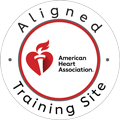Cardiac arrest claims hundreds of thousands of lives each year, yet survival rates vary dramatically based on how quickly and appropriately providers respond. Understanding the difference between shockable and non-shockable rhythms isn’t just academic knowledge—it’s a life-saving skill that directly impacts patient outcomes. When providers can rapidly identify rhythm types and implement the correct treatment protocol, survival rates increase significantly.
Defibrillation represents one of the most powerful interventions in emergency cardiac care, but its effectiveness depends entirely on delivering it to the right rhythm at the right time. This guide will equip healthcare providers with the knowledge to make that critical distinction confidently and quickly when every second counts.

What Are Cardiac Rhythms?
Understanding the Heart’s Electrical System
The human heart operates through a sophisticated electrical system that coordinates billions of contractions throughout a lifetime. This system begins in the sinoatrial (SA) node, the heart’s natural pacemaker, which generates electrical impulses that travel through specialized pathways, causing the atria and ventricles to contract in coordinated sequence. This electrical activity creates the patterns we see on electrocardiogram (ECG) monitors.
Normal vs Abnormal Heart Rhythms
A normal heart rhythm, or sinus rhythm, demonstrates regular electrical activity that produces effective mechanical contractions and adequate blood flow throughout the body. The ECG shows characteristic P waves, QRS complexes, and T waves in predictable patterns, with heart rates typically between 60 and 100 beats per minute in adults.
Abnormal rhythms, or arrhythmias, occur when this electrical system malfunctions. Some arrhythmias are relatively benign, while others prove immediately life-threatening. During cardiac arrest, the heart’s electrical activity becomes so disorganized or absent that mechanical pumping stops, eliminating blood flow to vital organs. The specific type of electrical dysfunction determines whether the rhythm responds to defibrillation.
Shockable Rhythms Explained
What Makes a Rhythm “Shockable”?
Shockable rhythms share a critical characteristic: disorganized but present electrical activity in the ventricles that can potentially be reset through defibrillation. These rhythms show chaotic or rapid electrical patterns that prevent effective cardiac contraction, but the heart retains enough electrical activity for a shock to potentially restore an organized rhythm.
The concept behind defibrillation involves depolarizing the entire myocardium simultaneously with a large electrical current. This momentary “reset” stops the chaotic electrical activity, allowing the heart’s natural pacemakers an opportunity to resume control and reestablish organized rhythm. Think of it as forcing a computer restart when the system has frozen—the goal is to clear the malfunction and allow normal operations to resume.
Ventricular Fibrillation (VFib)
Ventricular fibrillation represents the most common initial rhythm found in witnessed adult cardiac arrests, particularly those of cardiac origin. On the ECG monitor, VFib appears as rapid, chaotic, irregular waveforms with no discernible P waves, QRS complexes, or T waves. The electrical activity is completely disorganized, with multiple areas of the ventricle firing randomly rather than in a coordinated fashion.
The amplitude of VFib waves can vary from coarse (large, easily visible oscillations) to fine (small, barely perceptible waves). Coarse VFib generally indicates a more recent onset and responds better to defibrillation than fine VFib, which suggests prolonged arrest and depleted myocardial energy stores.
VFib is immediately fatal without intervention—the chaotic electrical activity produces no effective cardiac output, and the patient has no pulse, blood pressure, or consciousness. However, VFib also offers the best chance for successful resuscitation when treated promptly. With immediate CPR and defibrillation within the first few minutes, survival rates can exceed 50%. This dramatic response to early treatment makes VFib the rhythm where bystander intervention and rapid defibrillator deployment have the greatest impact.
The treatment protocol for VFib is straightforward but time-critical: immediate defibrillation using a single shock, followed immediately by high-quality CPR for two minutes before reassessing the rhythm. This cycle continues until the rhythm converts or changes to a non-shockable rhythm.
Pulseless Ventricular Tachycardia (VTach)
Pulseless ventricular tachycardia shares VFib’s critical characteristic of being immediately life-threatening yet responsive to defibrillation. Unlike VFib’s chaotic appearance, pulseless VTach shows rapid but organized ventricular activity on the ECG. The monitor displays wide, regular or slightly irregular QRS complexes occurring at rates typically exceeding 180 beats per minute.
The crucial distinction here is the word “pulseless.” VTach with a pulse represents a different clinical scenario with different treatment priorities. Pulseless VTach, however, produces no effective cardiac output despite organized electrical activity—the heart is beating too rapidly and inefficiently for the ventricles to fill with blood between contractions.
From a treatment standpoint, pulseless VTach receives identical management to VFib: immediate defibrillation followed by CPR. The electrical current disrupts the rapid ventricular focus driving the tachycardia, potentially allowing the normal rhythm to resume. Like VFib, early defibrillation significantly improves survival chances, making rapid recognition essential.
Healthcare providers must quickly differentiate pulseless VTach from VTach with a pulse during the initial assessment. If the patient is unresponsive, not breathing, and has no pulse, the organized-appearing VTach on the monitor is treated as a shockable rhythm requiring immediate defibrillation regardless of how “organized” it appears.
The Critical Time Window
Time represents the most critical factor in treating shockable rhythms. Research consistently demonstrates that survival rates from VFib cardiac arrest decrease by 7-10% for every minute that passes without defibrillation. This dramatic time-dependency creates an urgent imperative: the interval between collapse and delivery of the first shock must be minimized.
Consider the mathematics: after just five minutes without defibrillation, survival probability may drop by 35-50%. After ten minutes, the chances of survival with good neurological function become minimal. This reality drives the emphasis on early CPR, rapid defibrillator deployment, and minimizing any interruptions in treatment.
High-quality CPR between shocks partially mitigates this time-dependency by maintaining some blood flow to the heart and brain. CPR buys time, keeping the patient viable for defibrillation and preventing the rapid transition from coarse VFib to fine VFib or asystole. However, CPR alone rarely restores spontaneous circulation in shockable rhythms—defibrillation remains the definitive treatment, and CPR serves to maintain viability until that shock can be delivered and between subsequent shocks if needed.
Non-Shockable Rhythms Explained
What Makes a Rhythm “Non-Shockable”?
Non-shockable rhythms share a fundamental characteristic that makes defibrillation ineffective: they either lack electrical activity entirely or have organized electrical activity without effective mechanical function. In these cases, delivering an electrical shock serves no therapeutic purpose because there’s either nothing to reset (asystole) or the problem isn’t electrical disorganization that can be corrected by depolarizing the myocardium (PEA).
Understanding why defibrillation won’t help these rhythms reshapes the entire treatment approach. Instead of focusing on electrical therapy, providers must concentrate on supporting the patient through high-quality CPR while searching for and treating underlying causes. The heart needs mechanical support and correction of whatever factor is preventing effective function, not electrical intervention.
This distinction profoundly affects treatment priorities. With non-shockable rhythms, success depends on outstanding CPR technique, appropriate medication administration, and, most importantly, identifying and reversing the underlying cause of the arrest. While shockable rhythms often respond to the “shock” itself, non-shockable rhythms rarely convert without addressing their root cause.
Asystole (Flatline)
Asystole represents the complete absence of electrical activity in the heart. On the ECG monitor, asystole appears as a flat or nearly flat line—the “flatline” familiar from medical dramas. While dramatic in appearance, asystole is actually the most challenging rhythm to treat successfully, carrying the worst prognosis of all arrest rhythms.
The ECG in true asystole shows no discernible waves or complexes, just a flat baseline or minimal artifact. Before confirming asystole, providers must verify that ECG leads are properly connected and that gain settings are appropriate, as technical problems can mimic asystole. Some protocols recommend checking multiple leads to confirm the absence of activity and rule out fine VFib, which can sometimes resemble asystole.
Asystole can result from numerous causes, including prolonged VFib that has exhausted myocardial energy stores, massive myocardial infarction destroying the heart’s electrical system, severe hypoxia, drug overdose, severe electrolyte abnormalities, or hypothermia. In many cases, asystole represents the terminal rhythm after prolonged unsuccessful resuscitation from other arrest rhythms.
The treatment protocol for asystole focuses on high-quality CPR and immediate administration of epinephrine. Because there’s no electrical activity to shock, defibrillation plays no role in asystole management. Instead, providers must maintain mechanical circulation through chest compressions while searching aggressively for reversible causes. The prognosis for asystole remains poor, with survival rates typically under 2%, making prevention and early recognition of deterioration before asystole develops critically important.
Pulseless Electrical Activity (PEA)
Pulseless electrical activity presents a paradoxical situation: the ECG monitor shows organized electrical activity—sometimes even appearing relatively normal—yet the patient has no pulse or blood pressure. The heart displays electrical function but fails to produce effective mechanical contractions, a phenomenon called electromechanical dissociation.
PEA can appear as any organized rhythm on the monitor: narrow-complex rhythms, wide-complex rhythms, bradycardia, or even a normal-appearing sinus rhythm. The defining feature is the absence of a palpable pulse despite electrical activity. This discrepancy between electrical and mechanical function indicates that something is preventing the heart from contracting effectively or preventing blood from circulating even when contractions occur.
The key to treating PEA lies in understanding its reversible causes, traditionally taught as the “H’s and T’s”:
The H’s:
- Hypovolemia (severe fluid loss)
- Hypoxia (inadequate oxygenation)
- Hydrogen ions (severe acidosis)
- Hypo/hyperkalemia (potassium abnormalities)
- Hypothermia (low body temperature)
The T’s:
- Tension pneumothorax (collapsed lung with pressure)
- Tamponade (cardiac) (fluid around the heart)
- Toxins (drug overdoses or poisoning)
- Thrombosis (coronary or pulmonary)
- Trauma
Unlike shockable rhythms, where the primary problem is electrical, PEA almost always results from a specific underlying cause that must be identified and corrected. The organized electrical activity won’t generate effective circulation until the root cause is addressed. This search is reversible, which is the cornerstone of PEA management.
Treatment combines high-quality CPR with immediate epinephrine administration and an aggressive search for causes. Providers should systematically consider each H and T, looking for clues in the patient’s history, physical examination, and clinical context. When a reversible cause is identified and treated—whether that’s fluid resuscitation for hypovolemia, needle decompression for tension pneumothorax, or specific antidotes for toxins—PEA can potentially resolve, restoring effective circulation.
Key Differences in Treatment Approach
The management of shockable versus non-shockable rhythms diverges at fundamental levels, though both share high-quality CPR as a common foundation. Understanding these differences ensures providers deliver appropriate care efficiently during the chaos of cardiac arrest.
For non-shockable rhythms, CPR becomes the primary therapeutic intervention rather than a bridge to defibrillation. Chest compressions maintain some blood flow to vital organs and keep the possibility of recovery alive while other interventions take effect. The quality of CPR directly correlates with survival in these rhythms, making compression depth, rate, recoil, and minimal interruptions absolutely critical.
Medication administration follows different timelines based on rhythm type. In shockable rhythms, the initial focus is defibrillation, with epinephrine typically administered after the second shock if the rhythm persists. In contrast, non-shockable rhythms call for immediate epinephrine administration as soon as IV or IO access is established, then every 3-5 minutes throughout the resuscitation.
Perhaps the most critical difference lies in the treatment focus. Shockable rhythms often respond to defibrillation itself—the shock directly addresses the primary problem. Non-shockable rhythms, however, rarely convert without identifying and treating the underlying cause. This means providers managing PEA or asystole must think diagnostically even while performing resuscitation, constantly asking “Why did this happen?” and systematically addressing potential causes.
Recognition and Assessment
Rapid Rhythm Assessment During Cardiac Arrest
Speed and accuracy in rhythm recognition can determine patient outcomes. During cardiac arrest, providers must balance the need for quick rhythm identification with the imperative to minimize interruptions in CPR. The goal is to assess the rhythm in less than 10 seconds, make a treatment decision, and resume chest compressions immediately.
The assessment process begins the moment the team arrives at the patient. While some providers establish the patient’s condition (unresponsive, not breathing, pulseless), others should be preparing the defibrillator or AED. The rhythm check occurs when the monitor is connected and displays interpretable waveforms. This brief pause allows the team to identify the rhythm type and determine whether defibrillation is indicated.
Modern protocols emphasize continuous CPR except during rhythm checks and shock delivery. Even a few seconds’ delay in resuming compressions can impact outcomes. This reality makes efficient rhythm recognition a practiced skill—providers must train themselves to identify patterns quickly and decisively, avoiding the trap of prolonged rhythm analysis while the patient receives no CPR.
Using the AED or Manual Defibrillator
Automated external defibrillators simplify rhythm recognition by automatically analyzing the rhythm and advising whether a shock is indicated. AEDs prove highly accurate in distinguishing shockable from non-shockable rhythms, with sensitivity and specificity exceeding 95% in most studies. When the AED says “shock advised,” providers can trust that recommendation and deliver the shock immediately.
Manual defibrillators require providers to interpret the rhythm themselves, placing greater responsibility on the team’s assessment skills. However, manual defibrillators offer advantages in experienced hands: continuous rhythm monitoring, the ability to deliver shocks without waiting for automated analysis, and simultaneous assessment of other parameters like heart rate and QRS width.
Regardless of which device is used, the principle remains the same: minimize the time between rhythm check and appropriate intervention. With AEDs, this means following prompts quickly and resuming CPR immediately after shock delivery. With manual defibrillators, it means having the team prepared to charge the defibrillator during compressions if a shockable rhythm is anticipated, allowing immediate shock delivery once the rhythm is confirmed.
ECG Pattern Recognition
Building strong pattern recognition skills requires exposure to multiple examples of each rhythm type. VFib typically shows its characteristic chaotic, irregular pattern without organized waves. The amplitude varies, but the absence of any identifiable QRS complexes distinguishes it from other rhythms. Coarse VFib with larger amplitude waves usually indicates a more recent onset, while fine VFib suggests a prolonged arrest.
Pulseless VTach displays wide, regular, or slightly irregular QRS complexes at rapid rates. The key is recognizing the combination of an organized-appearing rhythm on the monitor with the clinical finding of no pulse. This rhythm can sometimes appear almost regular, unlike VFib’s complete chaos.
Asystole shows a flat or nearly flat line, though a minimal artifact or wandering baseline may be present. The critical skill here is distinguishing true asystole from fine VFib, as they require different treatments despite similar appearance. When in doubt, checking multiple leads and ensuring proper ECG gain can help clarify the rhythm. Some protocols recommend treating uncertain fine VFib/asystole situations as VFib, given the better prognosis with defibrillation.
PEA encompasses any organized rhythm without a pulse. The ECG might show narrow or wide complexes, fast or slow rates, or even relatively normal-appearing rhythms. The diagnosis relies on the clinical finding of organized electrical activity on the monitor, combined with the absence of a palpable pulse and blood pressure.
Common recognition pitfalls include mistaking artifacts from CPR or patient movement for VFib, missing fine VFib by interpreting it as asystole, and failing to verify the patient’s pulse status when seeing organized rhythms. Regular practice with rhythm strips and simulation training builds the pattern recognition skills that enable quick, accurate identification in real emergencies.
Conclusion
Key Takeaways
The distinction between shockable and non-shockable rhythms forms the foundation of effective cardiac arrest management. Ventricular fibrillation and pulseless ventricular tachycardia demand immediate defibrillation, offering the best chance for survival when treated quickly. Asystole and pulseless electrical activity require a different approach centered on high-quality CPR, early medications, and identification of reversible causes.
Ready to master cardiac rhythm recognition and emergency response? CPR Tampa American Heart Association-certified courses provide stress-free, hands-on training in BLS, ACLS, and PALS. Our expert instructors ensure you’re confident and prepared for any cardiac emergency. Enroll today and become the provider who makes the difference when seconds count.


